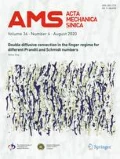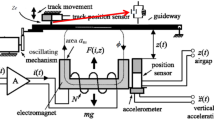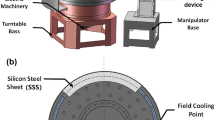Abstract
In this study, the intrinsic mechanism of aerodynamic effects on the motion stability of a high-speed maglev system was investigated. The concept of a critical speed for maglev vehicles considering the aerodynamic effect is proposed. The study was carried out based on a single magnetic suspension system, which is convenient for proposing relevant concepts and obtaining explicit expressions. This study shows that the motion stability of the suspension system is closely related to the vehicle speed when aerodynamic effects are considered. With increases of the vehicle speed, the stability behavior of the system changes. At a certain vehicle speed, the stability of the system reaches a critical state, followed by instability. The speed corresponding to the critical state is the critical speed. Analysis reveals that when the system reaches the critical state, it takes two forms, with two critical speeds, and thus two expressions for the critical speed are obtained. The conditions of the existence of the critical speed were determined, and the effects of the control parameters and the lift coefficient on the critical speed were analyzed by numerical analysis. The results show that the first critical speed appears when the aerodynamic force is upward, and the second critical speed appears when the aerodynamic force is downward. Moreover, both critical speeds decrease with the increase of the lift coefficient.













Similar content being viewed by others
References
Lee, H.W., Kim, K.C., Lee, J.: Review of maglev train technologies. IEEE Trans. Magn. 42, 1917–1925 (2006)
Dai, G.C.: 600 km high-speed maglev project started in China: build a test line within 5 years. The Study News [2016.11.13]. http://www.thestudy.cn/newsDetail_forward_1557972
Wu, J.J., Shen, F., Shi, X.H.: Stability and hopf bifurcation of maglev control system. J. Vib. Shock 29, 193–196 (2010). (in Chinese)
Li, S.Q., Zhang, K.L., Chen, Y., et al.: Judgment method of maglev vehicle dynamic stability of flexible track. J. Traffic Transp. Eng. 15, 43–49 (2015). (in Chinese)
Li, J.H., Li, J., Zhou, D.F., et al.: Self-excited vibration problems of maglev vehicle–bridge interaction system. J. Cent. South Univ. 21, 4184–4192 (2014)
Han, H.S., Yim, B.H., Lee, J.K., et al.: Effects of guideway’s vibration characteristics on the dynamics of a maglev vehicle. Veh. Syst. Dyn. 47, 309–324 (2009)
Wu, J.J., Zheng, X.J., Zhou, Y.H., et al.: The nonlinear dynamic characteristics of an EMS maglev control system with two-stage suspension. Acta Mech. Solida Sin. 24, 68–74 (2003). (in Chinese)
Zheng, X.J., Wu, J.J., Zhou, Y.H.: Numerical analyses on dynamic control of five-degree-of-freedom maglev vehicle moving on flexible guideways. J. Sound Vib. 235, 43–61 (2000)
Zheng, X.J., Wu, J.J., Zhou, Y.H.: Effect of spring non-linearity on dynamic stability of a controlled maglev vehicle and its guideway system. J. Sound Vib. 279, 201–215 (2005)
Wang, H.P., Li, J., Zhang, K.: Stability and Hopf bifurcation of the maglev system with delayed speed feedback control. Acta Autom. Sin. 33, 829–834 (2007)
Wang, H.P., Li, J., Zhang, K.: Non-resonant response, bifurcation and oscillation suppression of a non-autonomous system with delayed position feedback control. Nonlinear Dyn. 51, 447–464 (2008)
Wang, H.P., Li, J., Zhang, K.: Sup-resonant response of a nonautonomous maglev system with delayed acceleration feedback control. IEEE Trans. Magn. 44, 2338–2350 (2008)
Zhang, L.L., Campbell, S.A., Huang, L.H.: Nonlinear analysis of a maglev system with time-delayed feedback control. Phys. DNonlinear Phenom. 240, 1761–1770 (2011)
Zhang, L.L., Huang, L.H., Zhang, Z.Z.: Hopf bifurcation of the maglev time-delay feedback system via pseudo-oscillator analysis. Math. Comput. Modell. 52, 667–673 (2010)
Zhang, L.L., Huang, L.H., Zhang, Z.Z.: Stability and Hopf bifurcation of the maglev system with delayed position and speed feedback control. Nonlinear Dyn. 57, 197–207 (2009)
Yau, J.D.: Vibration control of maglev vehicles traveling over a flexible guide way. J. Sound Vib. 321, 184–200 (2009)
Zhou, D.F., Hansen, C.H., Li, J.: Suppression of maglev vehicle-girder self-excited vibration using a virtual tuned mass damper. J. Sound Vib. 330, 883–901 (2011)
Zhou, D.F., Li, J., Hansen, C.H.: Application of least mean square algorithm to suppression of maglev track-induced self-excited vibration. J. Sound Vib. 330, 5791–5811 (2011)
Zhou, D.F., Li, J., Zhang, K.: Amplitude control of the track-induced self-excited vibration for a maglev system. ISA Trans. 53, 1463–1469 (2014)
Li, J.H., Li, J., Zhou, D.F., et al.: The active control of maglev stationary self-excited vibration with a virtual energy harvester. IEEE Trans. Ind. Electron. 62, 2942–2951 (2015)
Li, J.H., Fang, D., Zhang, D., et al.: A practical control strategy for the maglev self-excited resonance suppression. Math. Problems Eng. 2016, 1–9 (2016)
Zeng, X.H., Wu, H., Lai, J., et al.: Influences of aerodynamic loads on hunting stability of high-speed railway vehicles and parameter studies. Acta. Mech. Sin. 30, 889–900 (2014)
Zeng, X.H., Wu, H., Lai, J., et al.: Hunting stability of high-speed railway vehicles on a curved track considering the effects of steady aerodynamic loads. J. Vib. Control 22, 4159–4175 (2016)
Li, S.Y., Zheng, Z.J., Yu, J.L., et al.: Dynamic simulation and safety evaluation of high-speed trains meeting in open air. Acta. Mech. Sin. 32, 206–214 (2016)
Kwon, S.D., Lee, J.S., Moon, J.W., et al.: Dynamic interaction analysis of urban transit maglev vehicle and guideway suspension bridge subjected to gusty wind. Eng. Struct. 30, 3445–3456 (2008)
Yau, J.D.: Aerodynamic vibrations of a maglev vehicle running on flexible guide ways under oncoming wind actions. J. Sound Vib. 329, 1743–1759 (2010)
Wu, J.J., Shi, X.H.: Numerical analyses of dynamic stability of maglev vehicles in crosswind field. J. Lanzhou Univ. (Nat. Sci.) 45, 96–102 (2009). (in Chinese)
Moon, F.C.: Magneto-Solid Mechanics. Wiley, New York (1984)
Tian, H.Q.: Train Aerodynamics. China Railway Publishing House, Beijing (2007). (in Chinese)
Zeng, X.H., Wu, H., Lai, J., et al.: The effect of wheel set gyroscopic action on the hunting stability of high-speed trains. Veh. Syst. Dyn. 55, 924–944 (2017)
Cheng, Y.C.: Hunting stability analysis of a railway vehicle system using a novel non-linear creep model. Proc. Inst. Mech. Eng. Part F. J. Rail Rapid Transit 226, 612–629 (2012)
True, H.: Multiple attractors and critical parameters and how to find them numerically: the right, the wrong and the gambling way. Veh. Syst. Dyn. 51, 443–459 (2013)
Iwnicki, S.: Handbook of Railway Vehicle Dynamics. CRC Press, London (2006)
Wu, J.J., Yang, W.W.: Dynamic character of EMS maglev train/nonlinear elastic guideway system. J. Lanzhou Univ. (Nat. Sci.) 42, 120–126 (2006). (in Chinese)
Acknowledgements
The project was supported by the National Key Research and Development Program of China (Grant 2016YFB1200602), the National Natural Science Foundation of China (Grants 11672306, 51490673), the Strategic Priority Research Program of the Chinese Academy of Sciences (Grant XDB22020101), the National Basic Research Program (973 Program) of China (Grant 2014CB046801), and the State Key Laboratory of Hydraulic Engineering Simulation and Safety (Tianjin University).
Author information
Authors and Affiliations
Corresponding author
Rights and permissions
About this article
Cite this article
Wu, H., Zeng, XH. & Yu, Y. Motion stability of high-speed maglev systems in consideration of aerodynamic effects: a study of a single magnetic suspension system. Acta Mech. Sin. 33, 1084–1094 (2017). https://doi.org/10.1007/s10409-017-0698-z
Received:
Revised:
Accepted:
Published:
Issue Date:
DOI: https://doi.org/10.1007/s10409-017-0698-z




